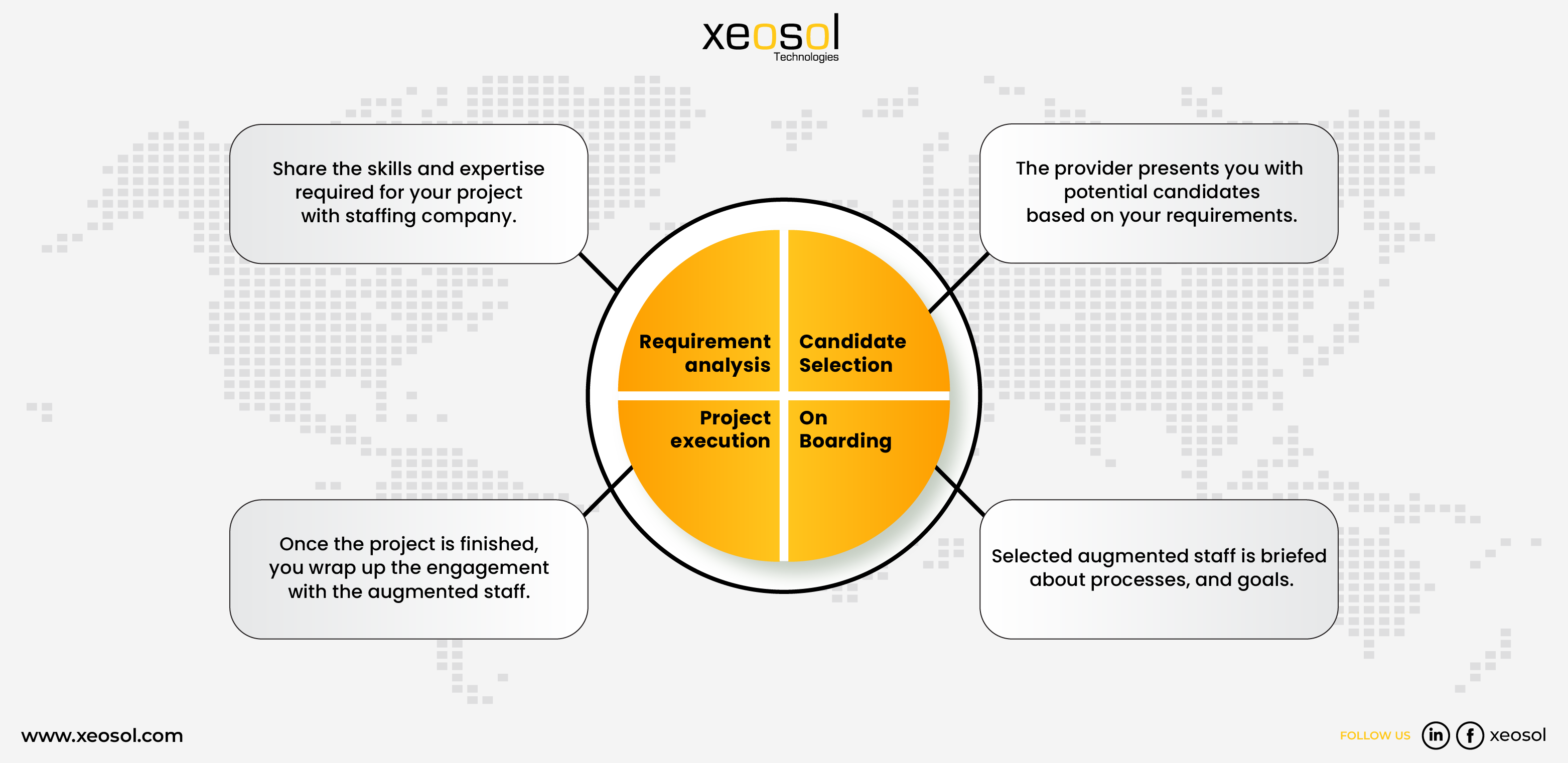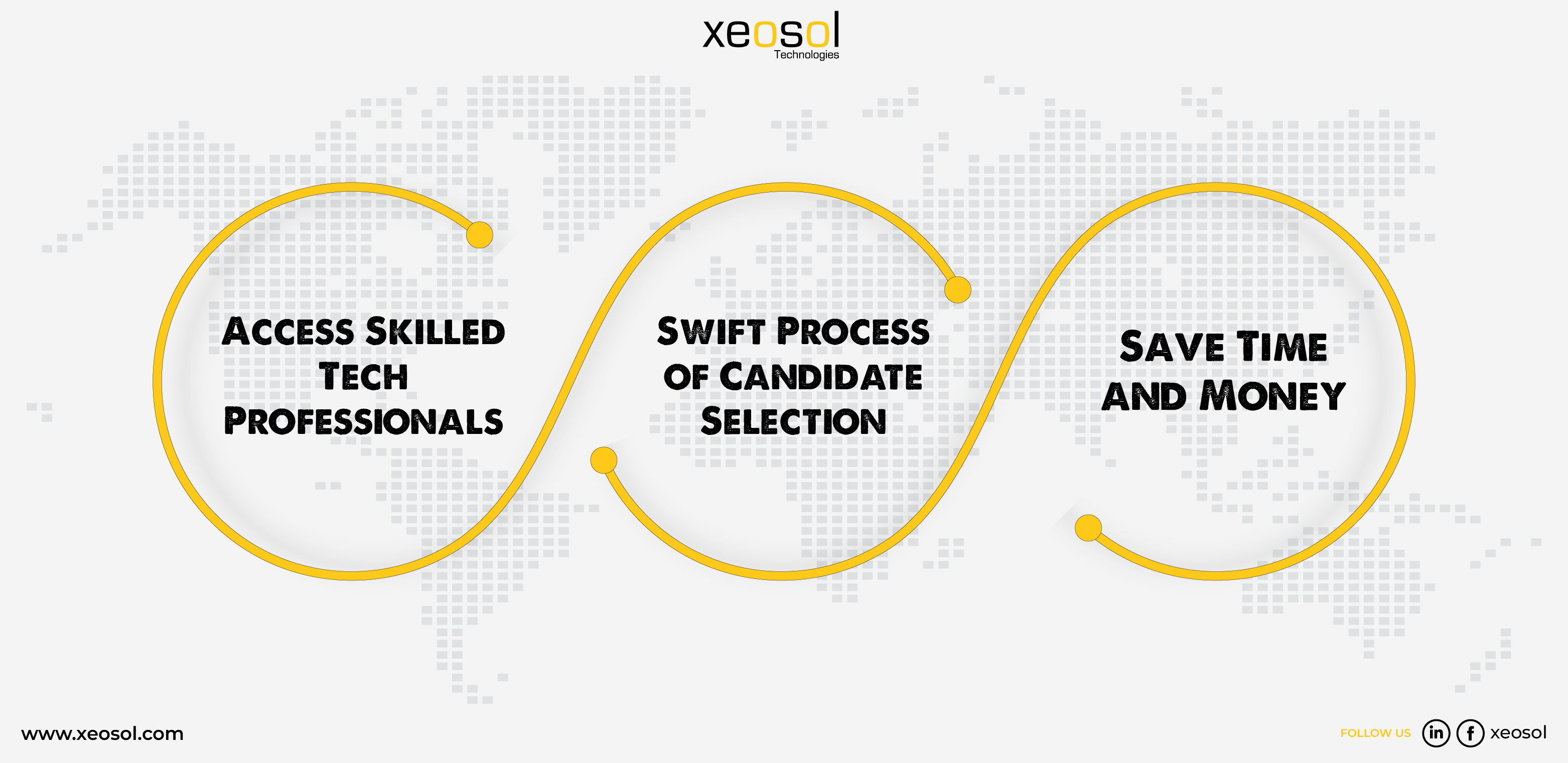What Is the Difference Between Staff Augmentation and Managed Services?
In today's fast-changing business world, companies often need extra help to complete projects and keep things running smoothly. They have two main options: staff augmentation and management services. Both of these approaches aim to give the help and knowledge needed, but they have some important differences. Therefore, a company's employees are really valuable.
As nowadays businesses have more choices than before. They aren't limited to hiring people from nearby places. With technology and remote work, they can hire talented people from all around the world.
Imagine you need help for your business. You can either go for managed services or staff augmentation. Let's understand the differences between these two options. This guide will explain everything clearly so you can choose what's best for your goals.
What is Staff Augmentation?
The practice of recruiting temporary personnel or experts to supplement your current workforce for a specific project or period is referred to as Staff Augmentation. Basically, it means offshore talent who can work together with your own team and provide an additional set of hands and skills when you need them the most.
This is especially useful in the IT field, where these extra workers can join your team to provide extra skills and help when needed. Businesses can increase staff for different stages of development processes such as programming, process optimization, quality assurance and control. This helps you to address some bottlenecks, contract key skills your team may have lost, meet the budget and time constraints, correct any errors or speed up product launch.
-
• How Does Staff Augmentation Work?
IT Staff augmentation is a service that helps add extra people to your team for a specific project or time. They hire temporary workers or experts to join your group. Here's how it usually works:

First, figure out what skills and knowledge your project needs. See where your team might need more help. Then, find a staff augmentation outsourcing company that's good at adding extra people to your team. They know lots of qualified people. They'll show you some possible team members based on what you need. You can talk to them and pick the ones that fit your project the best. Once you choose, these new team members get to know your team and how you work. They might need some training to fit in. They'll work together with your team, using their skills to help with the project. Alongside your main team, offshore talent will work on different parts of the project, like making and testing things.
However, it's really important for everyone to talk and share ideas to make things go well. Keep an eye on how well the new team members are doing, tell them how they're doing, and make sure they're helping the project like you want. If you need more or fewer extra team members, you can change the number to fit the project. When the project is done, you finish working with the new team members. Finally, using extra team members like this lets you get special skills without hiring full-time workers. It helps fill in what your team might be missing, gets things done on time, and makes your team better at finishing projects.
Visit: https://xeosol.com -
• What are different types of Staff Augmentation?
There are several types of Staff Augmentation:
-
I. Skill-Based Augmentation:
Bringing in experts with specific skills needed for a project or task. -
II. Temporary Staffing:
Hiring temporary workers for short-term needs. -
III. Project-Based Augmentation:
Adding staff for the duration of a particular project. -
IV. Long-Term Augmentation:
Hiring staff for an extended period, but not as permanent employees. -
V. Full-Time Equivalents (FTE) Augmentation:
Hiring staff who work similar hours as full-time employees, often for ongoing support. -
VI. Onshore, Offshore, Nearshore Augmentation:
Hiring staff from your own country (onshore), another country (offshore), or a nearby country (nearshore) based on cost and expertise. -
VII. Specialized Augmentation:
Adding experts in niche or specialized areas. -
VIII. Seasonal Augmentation:
Hiring temporary staff to handle seasonal spikes in workload. -
IX. Emergency Augmentation:
Quickly adding staff in response to unexpected needs or emergencies. -
X. Gap-Filling Augmentation:
Hiring staff to fill skill or resource gaps temporarily. -
XI. Advisory Augmentation:
Bringing in consultants or advisors to offer guidance and expertise.
-
-
• What are the major challenges associated with staff augmentation?
-
1. Building Long-Term Relationships:
Choosing staff augmentation for extended projects can have challenges. Sometimes, workers from the outside might need to do more tasks or even leave the company providing them. -
2. Cost Worries:
Staff augmentation might not be the cheapest choice for long projects. It could end up costing more than having your own permanent employees, but this depends on how good you are at hiring and keeping your own team. -
3. Becoming Reliant:
Using staff augmentation a lot might make you rely too much on one outside company. -
4. Finding Enough Workers:
Sometimes, one company might not have enough workers for you. So, you might need to use different companies and workers, and this might make the quality of work uneven. -
5. Integration Challenges:
Incorporating external staff seamlessly into your existing team and processes can sometimes be challenging, potentially leading to communication and collaboration issues. -
6. Limited Ownership:
Since augmented staff are not permanent employees, they might lack a deep understanding of your company's culture and long-term goals.
-
-
• Benefits of Staff Augmentation?
-
1. Flexibility:
Staff augmentation offers unparalleled flexibility, allowing you to quickly scale your team up or down based on project demands. This agility is particularly valuable for businesses that experience fluctuating workloads. -
2. Specific Expertise:
When you opt for staff augmentation, you gain access to highly specialized skills that might be lacking in your current team. This infusion of expertise can enhance project efficiency and quality. -
3. Cost-Efficiency:
Since staff augmentation involves hiring temporary resources, you can avoid the long-term financial commitments associated with full-time employees. This can lead to significant cost savings, especially for short-term projects.
-
What Are Managed Services?
The managed service model is a type of outsourcing where the company outsources certain functions to third party providers, known as managed service providers or MSPs. In fact, companies may subcontract almost anything to the managed service providers. This could be cybersecurity, data transfer or database management as well as software development.
On the contrary to Staff augmentation, this approach means to outsource management and responsibility for certain business activities or procedures to a foreign service provider. Assuming end to end control over the specified area, that service provider shall be an extension of your business.
-
• What are the prime components of managed services?
The management service providers are operated independently in comparison to being part of an internal IT team. In addition to providing a quote and project timetable, they shall communicate with their client regularly in order to carry out the assigned tasks after approval. The managed services model, by reducing the need for overhead work, human resources and resource management, is cost effective. Rather than supervising its work on a day-to-day basis, the company could focus on other business tasks and become connected with their managed service provider for daily or weekly progress reports.
-
• What are the financial advantages of managing your IT services?
The use of managed IT services has several financial advantages:
-
i. Cost Predictability:
Managed IT services often come with a fixed monthly fee, making it easier to budget and plan for IT expenses. -
ii. Reduced Labor Costs:
Outsourcing IT tasks can be more cost-effective than hiring and training in-house staff, especially for specialized skills. -
iii. Access to Expertise:
Managed IT service providers bring a team of skilled professionals, giving you access to a wide range of expertise without the cost of hiring individual specialists. -
iv. Minimized Downtime:
Swift and proactive IT maintenance helps prevent costly downtime that can disrupt operations and lead to financial losses. -
v. Scalability:
Managed services can be adjusted to your needs, allowing you to scale up or down without the costs associated with hiring or laying off employees. -
vi. Efficiency and Productivity:
Effective IT management improves overall efficiency, productivity, and workflow, translating to better use of resources and reduced waste. -
vii. Advanced Technology:
Access to cutting-edge technologies and tools through managed services without the high initial investment can save you money in the long run. -
viii. Security and Compliance:
Managed IT services enhance security measures and help ensure compliance, reducing the risk of costly breaches or legal penalties. -
ix. Focus on Core Business:
Outsourcing IT tasks lets you concentrate on your core business activities, potentially leading to increased revenue and growth. -
x. Lifecycle Management:
Managed services providers handle equipment maintenance, upgrades, and replacements, saving you from unexpected capital expenditures.
-
Key Differences between Staff Augmentation and Managed services in a Nutshell:
| Aspect | Staff Augmentation | Managed Services |
|---|---|---|
| Purpose | Temporary skill supplementation | Comprehensive IT management |
| Focus | Specific tasks or projects | Holistic IT support |
| Duration | Short-term or project-based | Ongoing, long-term engagement |
| Control | High client control over tasks | Service provider manages |
| Strategic Focus | Tactical, short-term perspective | Strategic, long-term vision |
IT staff augmentation with Xeosol:
Through Team Augmentation, our team seamlessly integrates with yours. We meticulously choose team members to match your specific needs and expertise. They fully immerse themselves in your project, embracing your company culture and aligning with your strategic objectives.

-
• Build Your Team with Xeosol in Four Simple Steps:
- Explain What you need, project and goals
- Arrange a meeting for Customized plan
- Select your team
- Select your team
Conclusion
There is no one size fits all answer to the question of staff expansion versus management services. The nature of your projects, the objectives that you have and the availability of resources are a decisive factor for your choice.
Staff Augmentations allow you to draw on external expertise and flexibility, while managed services provide a simpler way of running your business. Take into account the special needs of you, and begin a path that best enables your business to move forward.




